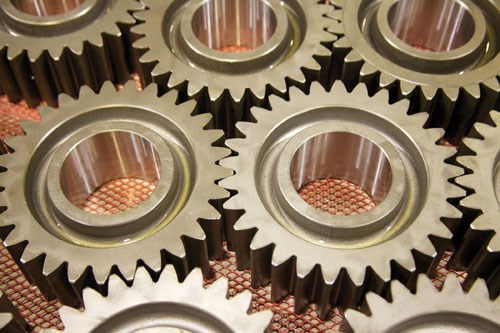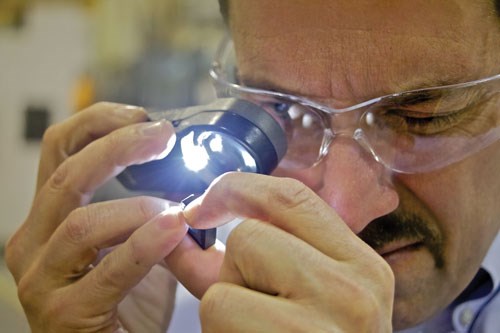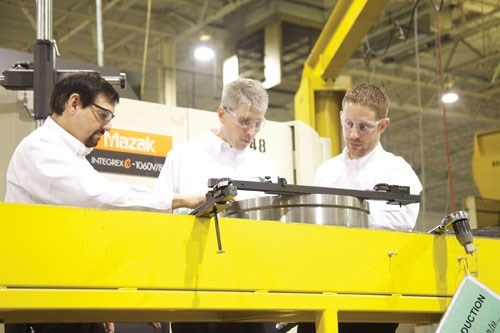When incoming orders surge and capacity grows scarce, the first instinct at Avon Gear isn’t adding more spindles. First, the company seeks to free machines for additional work by making existing processes more efficient. In many of these instances, technology and application support from Seco Tools (Troy, Michigan) have proven critical, says Dave Share, president of Avon Gear. Recent examples include reducing cycle time on cast iron applications, reducing idle time for hole-making applications, improving cutting tool inventory management and eliminating secondary grinding operations on hard-turned components.
Avon Gear specializes in low-volume, complex components for the off-highway, construction, mining and agricultural industries. True to its name, the 190-employee company works mostly with parts that have gear teeth and splines, although it also pursues general machining contracts. Typical jobs involve housings, shafts, gears and other components used in transmissions and torque converters. To process that work, the company’s facility in Shelby Township, Michigan houses a variety of lathes, including standard turning centers, live-tool models and vertical turning lathes for parts as large as 72 inches in diameter.
Finding new efficiencies to cope with increased business often involves reducing cycle time directly. Such was the case when the shop adopted Seco’s TK2001 insert grade. Treated with the supplier’s Duratomic coating process, this hard, fine-grained, tungsten carbide turning grade is designed for both light and heavy cuts in nodular cast iron and gray cast iron. Adopting the new grade enabled Avon Gear to run various jobs at more aggressive feeds and speeds without adjusting part programs, and tool life increased as well. For one particular cast iron job, cycle time dropped from 26 minutes to 16 minutes, recalls Matt Korth, engineering manager.
When cycle time can’t be reduced directly, the shop often looks to reduce machine idle time. One instance involved replacing standard drills with Seco’s CrownLoc exchangeable cutting head tooling. Now, operators change only the cutting head when a drill wears, as opposed to the whole tool assembly. In addition to speeding tool changes, the system provides cost savings on a number of levels: the tips are less expensive than new tools, there are no regrinding or resetting costs, and the shop can maintain less tooling inventory. According to the supplier, the tips’ geometries and TiAlN coatings ensure quality holes by enhancing entering capabilities, aiding chip evacuation and providing wear resistance in a variety of materials, including stainless steel and superalloys.
Another technology that helps maximize machine uptime is the Seco Point tooling inventory management system. Supply Pro point-of-use dispens-ing units ensure that needed tools are always close at hand. As a result, machinists no longer have to waste time walking to the company tool room, Mr. Share says. He adds that the system’s ability to automatically reorder supplies as needed has eliminated over-ordering. In fact, Avon Gear has reduced tooling inventory by 25 percent since installing the system. Additionally, the system’s ability to track tool use makes it easier for the company to recognize when consumption levels of a particular cutter skyrocket in a particular area. That helps investigate potential machining and process problems.
Other efficiency improvements involve rethinking a job’s entire production sequence. For example, Avon Gear has been working hand-in-hand with Seco to test CBN wiper inserts that promise to eliminate the need for secondary grinding after a hard-turning operation, provided the shop can get process approval from the customer. The part in question is heat-treated to between 60- and 70-HRc hardness prior to machining a spline. This sequence leaves a significant amount of extra material that must be machined away, so any insert must be able to withstand the rigors of cutting both the hardened stock and the softer material underneath.
The CBN wiper geometry has proven fit for the task, Mr. Korth says. The insert is designed for high-feed machining of case-hardened steel. More specifically, it is intended for operations in which standard wipers cannot be used because of vibrations caused by weak setups or lower radial cutting forces. The insert has wipers on both sides of their corner radii, which, according to Seco, is not uncommon. The difference is that the protection chamfer is twisted from negative to positive or from positive to negative. This design is said to achieve smooth finishes by reducing the effects of the workpiece feed pattern created during conventional turning.
In each of these cases, new products alone didn’t account for the shop’s success. Technical support from Seco also played an important role, Mr. Share says. Sometimes, however, that support is not just beneficial, but critical—especially when finding capacity for new jobs depends on adopting new processes and equipment. One such instance was when the shop acquired a Mazak Integrex e-1550V five-axis multitasking machine to produce an electric drive housing for Caterpillar, one of the shop’s key customers. Despite the part’s thin walls, tight-tolerance bores, side and angle holes, and various other challenging features, the new machine proved able to complete all turning, milling and drilling operations in a single chucking.
However, obtaining the best machining results and shortest cycle times required Seco’s involvement from the beginning of the project, Mr. Korth says. “We were able to give Seco the print and say this is what we need to make, and Seco’s technical people went through it and told us exactly what tools and holders we needed,” he explains. “They also pointed out where we might have difficulties and suggested some solutions. That level of support took a lot of burden off of our engineering department.”
Given that Avon Gear engineers can’t claim to be experts in all aspects of manufacturing, this type of technical support from a supplier is invaluable, Mr. Share concludes. “With Seco, we’re getting an engineer for free.”





.png;maxWidth=970;quality=90)





















.png;maxWidth=300;quality=90)













